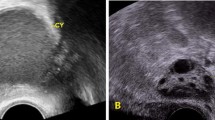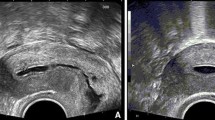Abstract
Objective
To investigate the value of painless transvaginal four-dimensional hysterosalpingo contrast sonography (TV 4-D HyCoSy) in reducing venous intravasation and its influencing factors through a retrospective comparative study on conventional TV 4-D HyCoSy.
Materials and methods
A total of 451 patients were enrolled in this study from Jan. 2019 to Oct. 2021. There were 249 patients in the painless TV 4-D HyCoSy group and 202 patients in the conventional TV 4-D HyCoSy group. The incidence of venous intravasation and its related influencing factors were analyzed and compared between these two groups. The difficulty of image evaluation for the diagnosis was also compared.
Results
There was no significant difference in the baseline characteristics between the painless group and the conventional group (p > 0.05). Compared with the conventional group, the painless group had a lower incidence of venous intravasation (16.9 vs. 24.8%; p = 0.039). Painless TV 4-D HyCoSy was more effective in reducing venous intravasation in patients with primary infertility (p = 0.032) without a history of pelvic surgery (p = 0.008) or ectopic pregnancy (p = 0.018). Logistic regression analysis demonstrated that painless TV 4-D HyCoSy and endometrial thickness > 5 mm were protective factors for venous intravasation. Moreover, the diagnostic procedure was easier in the painless group than in the conventional group (p = 0.002).
Conclusions
Painless TV 4D-HyCoSy may be an effective mode in reducing the incidence of venous intravasation and improving the diagnosis of patency of fallopian tubes.


Similar content being viewed by others
Data availability
The data that support the finding of this study are available from the corresponding author, upon reasonable request.
References
Louis JF, Thoma ME, Sørensen DN et al (2013) The prevalence of couple infertility in the United States from a male perspective: evidence from a nationally representative sample. Andrology 1(5):741–748
Bushnik T, Cook JL, Yuzpe AA, Tough S, Collins J (2012) Estimating the prevalence of infertility in Canada. Hum Reprod 27(3):738–746
National Collaborating Centre for Ws, Children's H. National Collaborating Centre for Ws, Children's H (2004) National Institute for Health and Clinical Excellence: guidance. Fertility: assessment and treatment for people with fertility problems. National Collaborating Centre for Women’s and Children’s Health. RCOG Press
Jain T (2006) Socioeconomic and racial disparities among infertility patients seeking care. Fertil Steril 85(4):876–881
He Y, Geng Q, Liu H, Han X (2013) First experience using 4-dimensional hysterosalpingo-contrast sonography with SonoVue for assessing fallopian tube patency. J Ultrasound Med 32(7):1233–1243
Chen F, Quan J, Huang P, You X (2017) Hysterosalpingo-contrast sonography with four-dimensional technique for screening fallopian tubal patency: let’s make an exploration. J Minim Invasive Gynecol 24(3):407–414
Wang W, Zhou Q et al (2018) Influence factors on contrast agent venous intravasation during transvaginal 4-dimensional hysterosalpingo-contrast sonography. J Ultrasound Med 37(10):2379–2385
He Y, Wu H, Xiong R et al (2019) Intravasation affects the diagnostic image quality of transvaginal 4-dimensional hysterosalpingo-contrast sonography with SonoVue. J Ultrasound Med 38(8):2169–2180
Shi J, Li S-S, Wu H et al (2019) The influencing factors of venous intravasation during transvaginal four-dimensional hysterosalpingo-contrast sonography with SonoVue. Ultrasound Med Biol 45(9):2273–2280
Ludwin A, Ludwin I, Martins WP (2018) Venous intravasation during evaluation of tubal patency by ultrasound contrast imaging. Ultrasound Obstet Gynecol 51(1):143–145
Saunders RD, Shwayder JM, Nakajima ST (2011) Current methods of tubal patency assessment. Fertil Steril 95(7):2171–2179
Schankath AC, Fasching N, Urech-Ruh C, Hohl MK, Kubik-Huch RA (2012) Hysterosalpingography in the workup of female infertility: indications, technique and diagnostic findings. Insights Imaging 3(5):475–483
Wang W, Zhou Q, Gong Y et al (2017) Assessment of fallopian tube fimbria patency with 4-dimensional hysterosalpingo-contrast sonography in infertile women. J Ultrasound Med 36(10):2061–2069
Guo J, Wang SS, Cheng Q et al (2014) Analysis on the countercurrent of contrast medium in transvaginal real-time three-dimensional hysterosalpingo-contrast sonography. Chin J Med Imag Technol 30(7):1063–1066
Savelli L, Pollastri P, Guerrini M et al (2009) Tolerability, side effects, and complications of hysterosalpingocontrast sonography (HyCoSy). Fertil Steril 92(4):1481–1486
Wang W, Zhou Q, Zhou X, Chen Z, Zhang H (2018) Influence factors on contrast agent venous intravasation during transvaginal 4-dimensional hysterosalpingo-contrast sonography. J Ultrasound Med 37(10):2379–2385
Dusak A, Ekinci F, Görük N et al (2013) Venous intravasation as a complication and potential pitfall during hysterosalpingography: re-emerging study with a novel classification. J Clin Imaging Sci 3(1):67
Bhoil R, Sood D, Sharma T et al (2016) Contrast intravasation during hysterosalpingography. Pol J Radiol 81:236–239
Tur-Kaspa I, Seidman DS, Soriano D et al (1998) Hysterosalpingography with a balloon catheter versus a metal cannula: a prospective, randomized, blinded comparative study. Hum Reprod 13(1):75–77
de Agostini A (2006) An unexpected role for anticoagulant heparan sulfate proteoglycans in reproduction. Swiss Med Wkly 136(37–38):583–590
McDonough PG (2004) Grading a developmental continuum–elegy on the rise and fall of the endometrial biopsy. Fertil Steril 82(5):1286–1292
Nor HM, Jayapragasam K, Abdullah B (2009) Diagnostic image quality of hysterosalpingography: ionic versus non ionic water soluble iodinated contrast media. Biomed Imaging Interv J 5(3):e29
Funding
This study was funded by National Natural Science Foundation of China (NO. 82272011). Natural Science Foundation of Guangdong Province (NO. 2022A1515012155). Shenzhen Futian District health public welfare program (NO. FTWS2021043, FTWS2021078, FTWS2021041). 2023 Guangdong Provincial Health Appropriate Technology Promotion Project (NO. 159).
Author information
Authors and Affiliations
Contributions
All authors contributed to the study conception and design. MC: project proposal/manuscript writing/data collection/statistical analysis; SH: manuscript writing/data collection/statistical analysis; EX: project development/manuscript editing; JF: project proposal/data collection; Other authors: data collection. The first draft of the manuscript was written by MC and SH, and all authors commented on previous versions of the manuscript. All authors read and approved the final manuscript.
Corresponding authors
Ethics declarations
Conflict of interest
The authors report no competing financial interests nor conflicts of interest.
Ethics approval
This study was approved by the the Ethics Committee of The Eighth Affiliated Hospital of Sun Yat-sen University (2022-057-02).
Consent for publication
All authors gave consent for publication.
Additional information
Publisher's Note
Springer Nature remains neutral with regard to jurisdictional claims in published maps and institutional affiliations.
Supplementary Information
Below is the link to the electronic supplementary material.
Rights and permissions
Springer Nature or its licensor (e.g. a society or other partner) holds exclusive rights to this article under a publishing agreement with the author(s) or other rightsholder(s); author self-archiving of the accepted manuscript version of this article is solely governed by the terms of such publishing agreement and applicable law.
About this article
Cite this article
Chen, M., Huang, S., Song, C. et al. Value of painless transvaginal four-dimensional hysterosalpingo contrast sonography in reducing venous intravasation: a comparative study. J Ultrasound (2024). https://doi.org/10.1007/s40477-023-00847-8
Received:
Accepted:
Published:
DOI: https://doi.org/10.1007/s40477-023-00847-8




